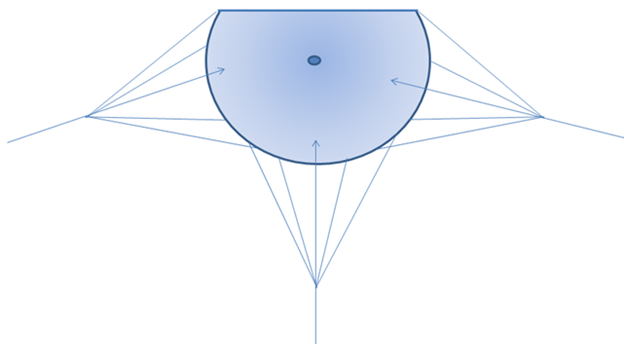Introducing ViViX–An Idea In My Head Anyway :-)
Virgin Virtual eXplorer (ViViX) (the name reflects that which could have been … And, I don’t feel like changing it right no), ViViX is a virtual Travel & Tourism, Leisure Entertainment, and Science (Space/Ocean) Exploration innovation. It is a big idea that could tight together several technology areas, but it requires a significant amount of money for research and development. Obviously I do not have such resources. I consider this both a great and useful idea that could make citizens of the world part of the fantastic experience in oceanic and space exploration. It could add significant value to oceanic research and astronauts training.
I don’t have overall quantifiable numbers, but just for sake of projections let’s take the # of visitors to Disney World each year: approx. 4.7 million visitors. Let’s say that only 10% of those visitors use the Augmented Reality ViViX Experience (ARVX) at 25$ each that is $117MM / year or US$353MM in a three-year period -- for just US Disney. This product can be deployed worldwide.
If we add the revenue from oceanic scientific research institutions and space agencies like NASA around the world, the revenue potential could be in the billions.
Virgin Virtual Explorer or (ViViX) leverages oceanic and space applications to bring unique experiences to the masses by means of recording oceanic and spaceship missions in three dimensions and projecting it inside a pool where each spatial plane from the real world is reproduced and projected inside the pool – including sound.
Virgin Virtual Explorer (ViViX) consists in capturing real world experiences in the ocean and space via high definition three-dimensional cameras. In order to accomplish it both oceanic submarines and the spaceships can be retrofitted with robotic apparatus in the form of external high definition recording devices (both video and sound) on each side of the vessel: front, back, left, right, and down (up no relevant as one cannot project up into the surface of the pool). Each recording plane maps to each side of the pool wall where the recreation of the environment takes place. The recording would take place in such a way that each video from each plane overlaps with the adjacent plane so that during video production, using advanced video processing, the edges of each plane are stitched together to provide a contiguous video playback.
For the recreation of the experience a special pool will be required so that the video and sound can be symmetrically projected out from each wall including the bottom. A viewer (user) immersed in the experience will have a three-dimensional surround view augmented by the water which will enhance realism by providing sensory (ocean) and gravitational (space) reality. The walls will be equipped with a proximity sensor so when the viewer approaches the wall the system can visually warn the viewer to avoid hitting the wall. The delivery experience would be even more fantastic if the recording itself was made using 3D (as in iMax) cameras. That could be the ultimate version.
Potential Applications
There are at least three potential areas of application for this system:
1. Travel, Tourism, and Entertainment
Businesses in these industries, around the world, could use the system to offer amazing, highly immersive and realistic experiences at parks and resorts. ViViX could be sold stand alone and further revenue could be secured by providing content and system maintenance. Disney World could be a main customer as well as others like it. Imagine being able to explore coral reefs from all over the world as if you were actually there.
2. Maritime Research
Maritime research is a very expensive undertaking. Researchers have to account for sophisticated equipment and technologies and this cost reoccurs for every exploratory mission with limited play back options. ViViX could play a significant role in the advancement of maritime research. For instance an unmanned, remote controlled (or autonomous) submarine could be used to explore the deep ocean and capture three-dimensional oceanic visuals in all of its splendor, then researchers at their research facility can simply and safely observe maritime life playing back the experience as many times as necessary and highly increasing their research observations and findings.
3. Astronauts/Cosmonauts Space Training
Currently NASA uses the Neutral Buoyancy Laboratory, which is a huge pool full of water. This lab leverages water to simulate space’s “zero” gravity. Astronauts training could be enhanced significantly by offering a more space-realistic environment. Like the oceanic sub(s), spaceships could be retrofitted in the same fashion and provide a training environment where the astronauts can feel as if they are actually in space. Both gravitationally as well as visually. The added value to their training, having a visually realistic experience, could be profound. This solution can be sold to any space training facility around the world.
It can also be used as entertainment at a park & resort to allow the public to experience what astronauts experience when doing space walks. And of course Bill Gates could build one of these in his backyard and explore the oceans of the world without risk… Imagine telling your rich friends come let me show you the deep ocean, turn the pool augmented reality system on and boom…
Diagrams
Figure 1: Cubical pool
Figure 2: Oval pool (best for dealing with edgeless playback
So there you have it. This is the one idea that I keep telling myself if I was Sir Richard Branson (oh wait!!! … Bill Gates) I would build it.
My hope is that you find Virgin Virtual Explorer (ViViX) intriguing and with high potential for profit… it would definitely be fun!
LET’S BULD IT!!!
THE TOOLS DEPARTMENT
free/trial tools for developers
- Think blue sky with Azure free trial
- Freedom of Expression with Visual Studio Express 2012
- Tools and SDKs from the Windows Developer Center
- A 30-day Windows App Adventure
- Tools and SDKs from the Phone Developer Center
- A 30-day Phone App Adventure





